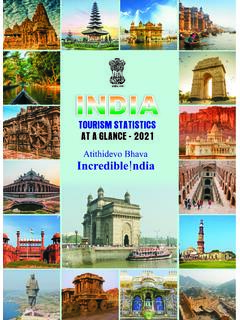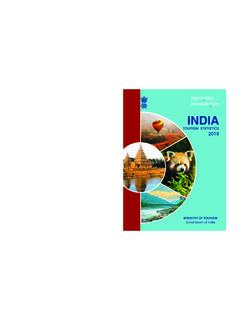Transcription of NO. 150 ADB BRIEFS
1 ADB BRIEFSNO. 150 SEPTEMBER 2020 ISBN 978-92-9262-353-1 (print)ISBN 978-92-9262-354-8 (electronic) ISSN 2071-7202 (print)ISSN 2218-2675 (electronic)Publication Stock No. BRF200245-2 DOI: Tourism amid the COVID-19 Pandemic1 KEY POINTS Tourism has been hit hard by COVID-19. As a major economic sector and source of foreign exchange earnings in many countries in Asia and the Pacific, the sudden fall in tourist arrivals is having severe economic and social consequences within and beyond tourism. This policy brief analyzes two strategies to revive tourism.
2 First is to promote domestic tourism. The analysis shows that in about half of the economies in the region domestic tourists could replace a considerable portion of international visitors, if fully mobilized. Second, in the recovery phase, countries can negotiate so-called travel bubbles. The potential of travel bubbles is estimated and their feasibility assessed given the pandemic and pandemic preparedness of countries (as of July 2020). To revive tourism successfully, governments together with travel and tourism sectors should prepare phased tourism recovery plans, in which travel bubbles can only be a stepping stone to a fully open regime.
3 During the recovery phase, governments need to rebuild tourist confidence and encourage innovation and investment for a resilient and sustainable tourism HelbleEconomistEconomic Research and Regional Cooperation DepartmentAsian Development Bank Anna FinkEconomist (Regional Cooperation) Sustainable Development and Climate Change Department Asian Development BankTRENDS BEFORE COVID-19 Tourism was one of the fastest growing sectors in Asia before the coronavirus disease (COVID-19) pandemic, with various factors driving strong growth.
4 Sustained economic growth in the region gave an increasing part of populations the financial means to travel domestically and internationally. In addition, an increasingly liberalized air transport market saw low-cost carriers emerging to offer inexpensive flights, and visa requirements became more accommodating, easing travel still further. Regional communities, such as the Association of Southeast Asian Nations, facilitated some of these addition, many Asian countries quickly recognized the potential of tourism to contribute to economic growth and to generate substantial foreign exchange earnings.
5 Tourism ranked high in government development plans around the region as a sector with high potential growth, especially for smaller countries with limited jobs in manufacturing but many tourist assets. Several Pacific island countries invested heavily in tourism. The abrupt fall in tourist arrivals and resulting demand plunge in the tourism sector due to COVID-19 has caused millions of job losses and economic hardships and wiped out many firms, especially the micro, small, and medium-sized enterprises that had catered to tourists or in related industries.
6 This section briefly looks at the main trends in tourism in Asia before COVID-19 to demonstrate the sector s dynamic development, on which many economies around the region were pinning hopes. 1 The policy brief was prepared under the overall guidance of Cyn-Young Park, Director of Regional Cooperation and Integration Division. The authors acknowledge valuable comments received from Hernan Epstein, Clara van der Pol, Aleli Rosario, and Yasuyuki Sawada; and capable research assistance of Sol Francesca BRIEFS NO.
7 1502 Figure 1 depicts the share of outbound tourists by subregion and the rest of the world between 2000 and Whereas Asian tourists accounted for a little more than 20% in 2000, in 2018 every third tourist in the world was from Asia and the Pacific. It should be noted that in absolute numbers, total tourists worldwide doubled from billion in 2000 to billion in 2018. The number of tourists from Asia tripled from million in 2000 to million in 2018. Growth was particularly strong in Southeast Asia, where the number of tourists increased more than six times, followed by South Asia, in which the number of travelers increased five times.
8 Asia and the Pacific has also become a major destination of international tourism over the past 2 decades. In relative terms, Central and West Asia grew most, followed by Southeast Asia and South Asia (Figure 2). East Asia, including Japan, was the largest destination within Asia and the Pacific, receiving million in 2018, up from million international tourists in 2000. Southeast Asia received million international tourists in 2018, Central and West Asia ( million), South Asia ( million), and the Pacific, including Australia and New Zealand ( million), according to the statistical database provided by the United Nations World Tourism Organization (UNWTO).
9 Not all economies in Asia depend on tourism to the same extent. The Tourism Satellite Accounts (UN and UNWTO 2008) established a methodology to measure the direct contribution of the tourism industry to gross domestic product (GDP). One measure to gauge the economic importance of tourism is based on inbound tourism expenditure as a percentage of GDP, as indicated in balance-of-payments statistics reported to the International Monetary Fund. This expenditure is estimated by combining the credit entries of the travel and passenger transport items.
10 Figure 3 shows the numbers for Asia and the Pacific by subregion based on data published by UNWTO. In Asia and the Pacific, we can distinguish between four groups of economies:(i) Highly tourism-dependent economies, where the direct contribution of tourism to GDP exceeds 10%: Cambodia; Fiji; Georgia; Hong Kong, China; Maldives; Palau; Thailand; Tonga; Samoa; and Vanuatu. 2 As developed member countries in the region Japan, Australia, and New Zealand are important tourist source countries, we included the number of their outbound tourists in East Asia and the Pacific, 1: Share of Outbound Tourists by Subregion of Origin, 2000 2018 (%)ANZ = Australia and New Zealand, EU = European Union, ROW = Rest of the World.















